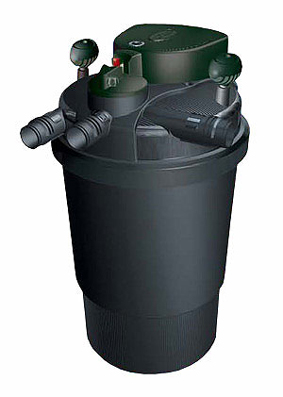Goldfish Pond Setup Affects Maintenance Required
A pond needs to be set up more carefully than an aquarium because changes are harder and more expensive to make.
One of the most important considerations for any goldfish pond setup is pond placement. Pond placement will govern how much sunlight strikes the pond. The amount of sunlight that strikes a pond affects:
- The filter size
- Aquatic plant selection
- Fish numbers and
- The amount of maintenance required.
The sections below give basic goldfish pond setup information for pond filters, UV sterilizers (clarifiers), substrate, plants, fish and pond covers. Follow the links for more detailed information on choosing the right equipment for your pond.
Pond Filters
 High volume canister type pond filter
High volume canister type pond filterThere are many filter options available on the market today. If you decide to install a filter (recommended), remember that it must run continuously otherwise useful bacteria won’t establish in the filter.
Remember also that a filter does little filtering. Its job is to circulate the water and provide a home for the colony of useful bacteria that convert waste into harmless compounds.
A pond filter should circulate the water at least once every two hours. Once every one hour is better.
You can’t over filter, but you can under filter. A sure sign the filter isn’t large enough is if you have to clean it out completely more than 4 times a year because of clogging.
Installing a filter also means you can increase the number of fish in the pond.
Read more on choosing the right filter...
Pond UV Water Sterilizers/Clarifiers
 External inline UV water clarifier
External inline UV water clarifierIf your pond water keeps going green despite having a filter, an easy option is to install a UV (ultraviolet) sterilizer also called a UV clarifier.
The difference between a sterilizer and a clarifier is clarifiers only remove algae that cause green water. Sterilizers can remove algae, bacteria and depending on strength, viruses.
A high intensity UV lamp kills bacteria and algae as they pass close to the lamp.
There are many options available. Some are fitted inline after the filter. Some filters come with a UV sterilizer which is very handy because you only have one power lead to deal with.
UV sterilizers, like filters, have to be the correct size for the pond they are being fitted to. This is why buying a filter with a sterilizer fitted guarantees the sterilizer is the correct size, (assuming the filter is the correct size for the pond).
Read more on choosing the right UV sterilizer...
Using Substrate In A Goldfish Pond Setup
For a pond, I generally wouldn’t use any substrate, especially if the pond is made from a liner. It is just too easy to puncture it.
The other problem with having substrate is that it tends to collect a lot of debris which then builds up over time causing ammonia pockets.
One argument for having substrate is for plants to root in. I tend to put plants into containers so I can easily remove them if I need to clean the pond or catch fish.
If you want to use substrate, the same rules apply as for aquariums; use smooth round stones about 1/4" (6mm) in diameter which will allow some water circulation to keep the gravel’s aerobic bacteria healthy.
The substrate should be dark in color so that the fish will display good coloration and be at least 2” (50mm) deep.
Pond Plants
Plants fulfill several functions in a pond. They can be used for:
- Decoration
- Providing shade
- Absorbing nutrients
- Protecting fish from enemies or
- A spawning medium.
Pond location is important if you want your plants to flourish.
If it is too shaded, plants such as lilies don’t do so well. But if the pond gets too much sunlight, the water will quickly turn green and submerged plants that require a reasonable amount of light will die.
Unsightly blanket weed will also establish itself choking all other aquatic plants and making swimming difficult for fish.
Submerged aquatic plants generally like clean clear water with low nutrient levels.
Don't forget that at night water plants give off carbon dioxide, reversing the process during the day. A heavily planted pond needs some form of water aeration at night.
Fish Numbers
Ponds are greatly influenced by what the weather is doing. Because of this, the fish population needs to be much smaller than the numbers you can keep in an aquarium.
Double the usual requirement of 24 square inches of water surface area per inch of fish (excluding the caudal fin). This allows for the higher heat in summer, direct sunlight and wind blown debris that seems to magically appear in your nice clean pond.
Pond Covers
Pond covers serve several purposes. They:
- Keep goldfish safe from enemies
- Stop small animals from getting trapped
- Stop larger debris from blowing into the water
- Provide a support to mount shade cloth on
- And most importantly, keep small children safe.
Pond covers do spoil the natural look of a goldfish pond setup somewhat, but the risks of not having one just aren’t worth it.
For more information on how and when to perform maintenance on a Goldfish pond click here...
Top of Goldfish Pond Setup page




